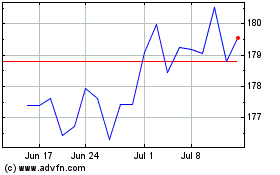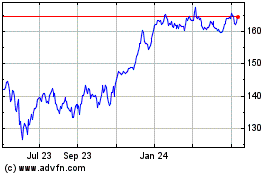Cord Cutters' Savings Shrink as Online TV Services Raise Prices
April 11 2019 - 1:17PM
Dow Jones News
By Drew FitzGerald
Online television bundles are getting bigger and prices keep
rising, edging closer to the cable bundles they were designed to
replace and muddling the economic equation that has prompted
millions of Americans to cut the cord.
YouTube TV, started two years ago as a lower-cost alternative to
cable, said this week it was raising its monthly rate by $10 to $50
and adding channels such as HGTV and Food Network. T-Mobile US
Inc., a wireless carrier that has been looking to jump into the
video business, said it would start selling a $100 monthly home-TV
service with more than 275 available channels.
YouTube TV joined a growing list of services padding their
online video bundles with more channels and raising prices in the
process. The service, which started with about 40 broadcast and
cable channels, now has more than 70 and costs 40% more than it did
when it was launched.
"We've been working to build a package that fits your needs,'"
YouTube TV vice president Christian Oestlien wrote in a blog post
detailing the change and eight new channels from Discovery
Communications Inc.
Alphabet Inc.-owned YouTube and Hulu are among a host of
companies that have tried to attack the pay-TV fortress that rules
the entertainment industry by launching slimmer bundles of channels
tailored to what individual customers want to watch. But as
programmers have raised the fees they charge to carry their
channels, the online services have had a harder time holding down
prices.
Streaming services Sling TV, DirecTV Now and Hulu, which have
signed up millions of subscribers in recent years, have all raised
the price of their lowest-tier video packages over the past year.
Much like customers can easily disconnect or cancel the services,
providers can also quickly change prices and channel packages.
Hulu, whose owners include Walt Disney Co. and Comcast Corp.,
illustrated a widening gap between on-demand brands and cable-like
bundles that carry live sports and news. The website lopped $2 off
the monthly cost of its basic library of situation comedies and
original dramas but added $5 a month to its live-TV package.
Dish Network Corp.'s Sling TV and AT&T Inc.'s DirecTV Now
are owned by traditional pay-TV companies wary of wounding their
most lucrative business. Both services have signed up millions of
new subscribers while their satellite brands lose customers, but
the growth comes at a cost to their bottom lines.
Disney and AT&T are also preparing to launch new on-demand
services later this year, as they seek to compete with Netflix
Inc., which has also recently raised its monthly fees. Disney is
expected to provide details on its new service later Thursday.
Online TV still undercuts traditional cable- and satellite-TV
subscriptions by avoiding service fees and charges for add-ons such
as DVR rentals. While U.S. television households with pay-TV
services fell to about 78% last year, off from 87% in 2008, the
amount they spend on such services hasn't, according to annual
surveys by industry tracker Leichtman Research Group. The average
home spent $107 a month on pay-TV service in 2018, according to
Leichtman's phone survey of 1,100 adults last fall.
T-Mobile last year spent $325 million to buy Layer3 TV, a
cable-like service offered in a few cities, with the goal of
designing a nationwide mobile video service for its cellphone
customers. But the service has struggled to gain the carriage
rights it needs to air many channels, according to people familiar
with the matter.
T-Mobile's service, rebranded TVision Home, is limited to eight
cities, including Chicago, Los Angeles and New York. The cellphone
carrier's customers can get a $10 monthly discount, but its total
cost approaches those from competing cable services and doesn't
include a broadband connection. Like a traditional cable feed, it
requires a set-top box connected to a television. The wireless
carrier says a mobile version of the service is still in the
pipeline.
"That's not very disruptive," BTIG analyst Walt Piecyk wrote in
a note to clients. "T-Mobile is offering a service that is nearly
identical to those from existing providers, even down to the remote
control, which actually has legacy cable buttons of red, green,
yellow and blue."
Write to Drew FitzGerald at andrew.fitzgerald@wsj.com
(END) Dow Jones Newswires
April 11, 2019 13:02 ET (17:02 GMT)
Copyright (c) 2019 Dow Jones & Company, Inc.
T Mobile US (NASDAQ:TMUS)
Historical Stock Chart
From Mar 2024 to Apr 2024

T Mobile US (NASDAQ:TMUS)
Historical Stock Chart
From Apr 2023 to Apr 2024
